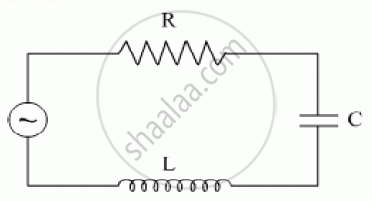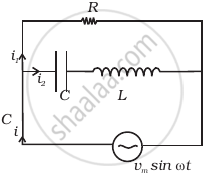Advertisements
Advertisements
Question
An LR circuit with emf ε is connected at t = 0. (a) Find the charge Q which flows through the battery during 0 to t. (b) Calculate the work done by the battery during this period. (c) Find the heat developed during this period. (d) Find the magnetic field energy stored in the circuit at time t. (e) Verify that the results in the three parts above are consistent with energy conservation.
Solution
(a) Let the current in the LR circuit be i.
Let the charge flowing through the coil in the infinitesimal time dt be dq.
Now,
\[i = \frac{dq}{dt}\]
∴ dq = idt
The current in the LR circuit after t seconds after connecting the battery is given by
i = i0 (1 − e−t/τ)
Here,
i0 = Steady state current
τ = Time constant = `L/R`
dq = i0 (1 − e−tR/L) dt
On integrating both sides, we get
\[Q = \int\limits_0^t dq\]
\[= i_0 \left[ \int\limits_0^t dt - \int\limits_0^t e^{- tR/L} dt \right]\]
\[ = i_0 \left[ t - \left( - \frac{L}{R} \right)( e^{- tR/L} - 1) \right]\]
\[ = i_0 \left[ t - \frac{L}{R}(1 - e^{- tR/L} ) \right]\]
Thus, the charge flowing in the coil in time t is given by
\[Q = \frac{\epsilon}{R}\left[ t - \frac{L}{R}(1 - e^{- tR/L} ) \right]\]
Where `i_0=epsilon/R`
(b) The work done by the battery is given by
W = εQ
From the above expression for the charge in the LR circuit, we have
\[W = \frac{\epsilon^2}{R}\left[ t - \frac{L}{R}(1 - e^{- tR/L} ) \right]\]
(c) The heat developed in time t can be calculated as follows:-
\[H = \int\limits_0^t i^2 Rdt\]
\[H = \frac{\epsilon^2}{R^2}R \int\limits_0^t (1 - e^{- tR/L} )^2 dt\]
\[H = \frac{\epsilon^2}{R} \int\limits_0^t \left[ (1 + e^{- 2tR/L} ) - 2 e^{- tR/L} \right]dt\]
\[H = \frac{\epsilon^2}{R} \left( t - \frac{L}{2R} e^{- 2tR/L} + \frac{L}{R}2 e^{- tR/L} \right)_0^t \]
\[H = \frac{\epsilon^2}{R}\left( t - \frac{L}{2R} e^{- 2tR/L} + \frac{L}{R}2 e^{- tR/L} \right) - \left( - \frac{L}{2R} + \frac{2L}{R} \right)\]
\[ = \frac{\epsilon^2}{R}\left\{ t - \frac{L}{2R}( x^2 - 4x + 3) \right\}...........\left(x = e^{- tR/L}\right)\]
(d) The magnetic energy stored in the circuit is given by
\[U = \frac{1}{2}L i^2 \]
\[ \Rightarrow U = \frac{1}{2}L\frac{\epsilon^2}{R^2} \left(1 - e^{- tR/L}\right)^2 \]
\[\Rightarrow U = \frac{L \epsilon^2}{2 R^2}(1 - x )^2\]
(e) Taking the sum of total energy stored in the magnetic field and the heat developed in time t
\[E = \frac{L \epsilon^2}{2 R^2}\left(1 - x\right)^2 + \frac{\epsilon^2}{R}\left\{ t - \frac{L}{2R}\left(x^2 - 4x + 3\right) \right\}\]
\[E = \frac{L \epsilon^2}{2 R^2}\left(1 + x^2 - 2x\right) + \frac{\epsilon^2}{R}t - \frac{L \epsilon^2}{2 R^2}\left(x^2 - 4x + 3\right)\]
\[E = \frac{L \epsilon^2}{2 R^2}\left(2x - 2\right) + \frac{\epsilon^2}{R}t\]
\[E = \frac{L \epsilon^2}{R^2}\left(x - 1\right) + \frac{\epsilon^2}{R}t\]
\[E = \frac{\epsilon^2}{R}\left\{ t - \frac{L}{R}\left(1 - x\right) \right\} = \frac{\epsilon^2}{R}\left\{ t - \frac{L}{R}\left(1 - e^{- tR/L}\right) \right\}\]
The above expression is equal to the energy drawn from the battery. Therefore, the conservation of energy holds good.
APPEARS IN
RELATED QUESTIONS
A voltage V = V0 sin ωt is applied to a series LCR circuit. Derive the expression for the average power dissipated over a cycle. Under what condition (i) no power is dissipated even though the current flows through the circuit, (ii) maximum power is dissipated in the circuit?
The figure shows a series LCR circuit with L = 10.0 H, C = 40 μF, R = 60 Ω connected to a variable frequency 240 V source, calculate
(i) the angular frequency of the source which drives the circuit at resonance,
(ii) the current at the resonating frequency,
(iii) the rms potential drop across the inductor at resonance.

A series LCR circuit is connected to an ac source. Using the phasor diagram, derive the expression for the impedance of the circuit. Plot a graph to show the variation of current with frequency of the source, explaining the nature of its variation.
The time constant of an LR circuit is 40 ms. The circuit is connected at t = 0 and the steady-state current is found to be 2.0 A. Find the current at (a) t = 10 ms (b) t = 20 ms, (c) t = 100 ms and (d) t = 1 s.
An LR circuit contains an inductor of 500 mH, a resistor of 25.0 Ω and an emf of 5.00 V in series. Find the potential difference across the resistor at t = (a) 20.0 ms, (b) 100 ms and (c) 1.00 s.
An inductor-coil of resistance 10 Ω and inductance 120 mH is connected across a battery of emf 6 V and internal resistance 2 Ω. Find the charge which flows through the inductor in (a) 10 ms, (b) 20 ms and (c) 100 ms after the connections are made.
The potential difference across the resistor is 160V and that across the inductor is 120V. Find the effective value of the applied voltage. If the effective current in the circuit be 1.0 A, calculate the total impedance of the circuit.
In a series, LCR circuit, obtain an expression for the resonant frequency,
In an LCR series a.c. circuit, the voltage across each of the components, L, C and R is 50V. The voltage across the LC combination will be ______.
In a series LCR circuit the voltage across an inductor, capacitor and resistor are 20 V, 20 V and 40 V respectively. The phase difference between the applied voltage and the current in the circuit is ______.
To reduce the resonant frequency in an LCR series circuit with a generator
Which of the following components of an LCR circuit, with a.c. supply, dissipates energy?
If the rms current in a 50 Hz ac circuit is 5 A, the value of the current 1/300 seconds after its value becomes zero is ______.
Consider the LCR circuit shown in figure. Find the net current i and the phase of i. Show that i = v/Z`. Find the impedance Z for this circuit.

A series LCR circuit containing a resistance of 120 Ω has angular resonance frequency 4 × 105 rad s-1. At resonance the voltage across resistance and inductance are 60 V and 40 V respectively. At what frequency the current in the circuit lags the voltage by 45°. Give answer in ______ × 105 rad s-1.
A series RL circuit with R = 10 Ω and L = `(100/pi)` mH is connected to an ac source of voltage V = 141 sin (100 πt), where V is in volts and t is in seconds. Calculate
- the impedance of the circuit
- phase angle, and
- the voltage drop across the inductor.
Which of the following statements about a series LCR circuit connected to an ac source is correct?
When an alternating voltage of 220V is applied across device X, a current of 0.25A flows which lags behind the applied voltage in phase by π/2 radian. If the same voltage is applied across another device Y, the same current flows but now it is in phase with the applied voltage.
- Name the devices X and Y.
- Calculate the current flowing in the circuit when the same voltage is applied across the series combination of X and Y.
A series LCR circuit is connected to an ac source. Using the phasor diagram, derive the expression for the impedance of the circuit.
